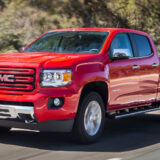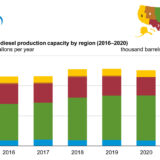U.S. fuel economy improvements are projected to reduce future gasoline use
The U.S. Energy Information Administration (EIA) is projecting a decline in light-duty vehicle energy use between 2018 and 2040, as improvements in fuel economy more than offset increases in light-duty vehicle miles.
Anticipated changes in energy consumption by light-duty vehicles in the United States are based on two factors: the amount of travel and the fuel economy of the vehicles used.
The number of vehicle miles traveled in the United States by light-duty vehicles set a record at 2.84 trillion miles in 2016. As the number of miles driven per vehicle has remained relatively steady at about 12,000 miles per vehicle, the recent increase in vehicle miles traveled is more attributable to an increase in the number of vehicles in use, according to the EIA’s Annual Energy Outlook 2017. Light-duty vehicle miles traveled per year are expected to continue to increase, ultimately reaching 3.33 trillion miles traveled in 2040, the report said.
The fuel economy of the light-duty vehicle stock is also expected to increase because of market developments and increases in fuel economy standards for new vehicles. Although sales of new vehicles make up a relatively small portion of the total light-duty vehicle fleet in any year and existing vehicles can remain on the road for many years, fuel economy standards for new vehicles and the mix of vehicles purchased have long-term implications for fuel consumption.
Light-duty vehicles are generally divided into two categories: passenger cars and light trucks. Fuel economy and greenhouse gas (GHG) standards are set for the two categories by the U.S. National Highway Traffic Safety Administration (NHTSA) and the U.S. Environmental Protection Agency (EPA). The standards applied by NHTSA and EPA are more stringent for passenger cars than for light trucks, and they are determined based on the vehicle footprint.
The EIA’s Annual Energy Outlook 2017 (AEO2017) projections reflect both the changes in the vehicle sales mix and the fuel economy standards that are applied separately to new passenger cars and light trucks.
For model year 2015, the required fuel economy standards averaged about 35 miles per gallon (mpg) for passenger cars and about 27 mpg for light trucks after taking into account the footprint mix of vehicles sold within each category. The standards for each category are currently required to increase over time so that the standards for model year 2025 vehicles are expected to reach about 53 mpg and 38 mpg, respectively. Because compliance fuel economy is based on a specific test procedure that applies certain credits, compliance fuel economy generally exceeds on-road fuel economy. For model year 2015, new vehicle on-road fuel economies averaged about 31 mpg for passenger cars and about 21 mpg for light trucks.
Despite an increasing share of vehicles classified as light trucks, the AEO2017 Reference case projects improved fuel economy of new light-duty vehicles and the in-use vehicle fleet through 2025 and beyond.
Based on the more stringent fuel economy standards covering model years through 2025 that have already been established, new on-road vehicle fuel economy for passenger cars is projected to increase 43% between 2015 and 2025, from 31 mpg in 2015 to 45 mpg. New on-road light truck fuel economy is projected to increase 46% over the same period, from 21 mpg to 31 mpg. Fuel economy of the overall vehicle stock rises more slowly, given the slower turnover of light-duty vehicles.
Fuel economy of the overall vehicle stock rises more slowly, given the slower turnover of light-duty vehicles. Because light trucks are projected to make up a growing share of the total light-duty vehicle fleet, the weighted average fuel economy is expected to be closer to that of light trucks. In the Annual Energy Outlook 2017 Reference case, on-road fuel economy of new light-duty vehicles increases from about 25 mpg in 2015 to 36 mpg in 2025.
Source: U.S. Energy Information Administration, Annual Energy Outlook 2017
.jpg)










